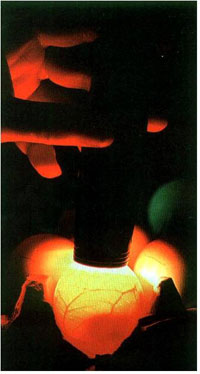



Parthenogenesis: Embryonic development in unfertilized eggs may impact normal fertilization and embryonic mortality
By C. D. McDaniel, PhD Professor, Poultry Science and published in MSU Poultry Dept. Spring Newsletter Vol. 1 Issue 1.Parthenogenesis refers to the ability of unfertilized chicken and turkey eggs to develop embryos. In 1953, Olsen and Marsden, two scientists at the Agricultural Research Center in Beltsville, Maryland, accidentally discovered parthenogenesis in turkeys. They found that 14% of the infertile eggs laid by Belts-ville Small White (BSW) turkeys developed partheno-genetically. However, almost all parthenogenic devel-opment in unfertilized turkey and chicken eggs is very unorganized and closely resembles normal embryonic mortality during the first three days of incubation in the fertilized egg.
 |
Unfortunately, the vast majority of research on parthenogenesis was conducted over 30 years ago by mostly a single scientist, M. W. Olsen, and almost entirely on a single noncommercial strain of turkey, the BSW turkey. More recently, a single study in 1998 found that 4% of the unfertilized eggs from modern commercial turkeys exhibited parthenogene-sis. A limited amount of very old parthenogenesis research with chickens does exist. About 15% of the freshly laid unfertilized eggs of Barred Plymouth Rock and White Leghorn hens exhibit embryonic development, but this development ceases when the eggs are incubated. Most infertile chicken eggs that develop embryos are from Dark Cornish, Silver Cor-nish, or Cornish crosses. Because of its breast con-formation, the Cornish chicken was used extensively to develop the modern day broiler breeder chicken. Therefore, it is very possible that the gene or genes controlling parthenogenesis in the Cornish chicken were passed on to the modern day broiler breeder. In fact, genetic selection drastically increases the inci-dence of parthenogenesis in turkeys. Parthenogene-sis in the BSW turkey was increased by genetic se-lection from 16.7 % in 1952 to 46 % in 1963. How-ever, research on genetic control of or genetic selec-tion for parthenogenesis in modern day poultry does not exist.
Parthenogenetic embryos have a time lag in de-velopment, usually requiring two days longer incu-bation time than do normal embryos from fertile eggs. Additionally, the incidence of parthenogenesis is greater in double yolk eggs as compared to single yolk eggs. Double yolk eggs remain in the uterus longer than single yolk eggs so that adequate shell can be created on such a large egg. Perhaps this ex-tra time in the uterus allows for a greater length of embryonic exposure to body temperature and more time for the delayed parthenogen to develop inside the hen’s body.
Furthermore, yolks destined to become the first eggs laid in a clutch or sequence of consecutive eggs are retained in the hen’s body for 16 h longer than subsequent yolks that will be released in a clutch. It is possible that first eggs in a clutch have a greater potential for developing advanced partheno-gens because of the increased length of exposure of the embryo to body temperature and the extra time required for the parthenogen to development. It is interesting to note that first eggs in a clutch exhibit more early embryonic mortality than subsequent eggs in the sequence, and most avian parthenogene-sis closely resembles early embryonic mortality. Perhaps, the early embryonic mortality described in previous studies in first of sequence eggs may par-tially be parthenogenic development of unfertilized eggs. This scenario may be particularly true in young hens, due to their short clutches and there-fore large percentage of first of sequence eggs. In fact, young hens have the highest incidence of early embryonic mortality, and parthenogenesis is highest in young BSW turkeys.
Our laboratory at Mississippi State University plans to examine the relationship of parthenogene-sis with normal fertilization and early embryonic mortality. It is very possible that the mechanisms regulating parthenogenesis may actually work against normal fertilization; hence, hens exhibiting parthenogenesis may have poor fertility. Addition-ally, because most parthenogenic development closely resembles early embryonic mortality in fer-tilized eggs during the first 3 days of incubation, it is very possible that many unhatched eggs being classified as containing early dead embryos may actually be unfertilized eggs that contain partheno-genic development. This inaccurate classification of unhatched eggs potentially would lead to errone-ously reported flock fertility. Our lab will also de-termine if genetic selection or incubation manage-ment can control any potential positive or negative relationship of parthenogenesis with normal fertili-zation or early embryonic mortality. Because chick production cost increases as reproductive perform-ance decreases, infertility and embryonic mortality (the two largest categories of reproductive failure in hatching eggs) represent the greatest economic losses in hatchability within the poultry industry. A better understanding of fertilization and the causes of early embryonic mortality will lead to great eco-nomic dividends to the poultry industry.








